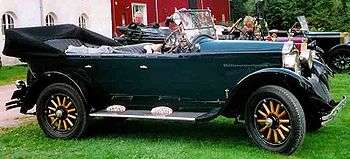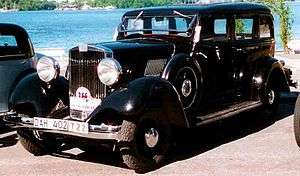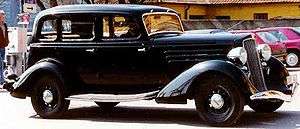Hupmobile
Coordinates: 42°22′53″N 83°02′04″W / 42.3814774°N 83.0343323°W
|
| |
| Automobile Manufacturing | |
| Industry | Automotive |
| Founded | 1909 |
| Defunct | 1940 |
| Headquarters | Detroit, Michigan, United States |
| Products |
vehicles Automotive parts |
Hupmobile was an automobile built from 1909 through 1939 by the Hupp Motor Car Company. The prototype was developed in 1908[1] and had its first successful run on November 8 with investors aboard for champagne at the Tuller Hotel a few blocks away.[2] The company was incorporated in November of that year. The first Hupmobile model, the Hupp 20, was introduced at the 1909 Detroit automobile show. It was an instant success.
History
Founding

.jpg)
Robert Craig "Bobby" Hupp (June 22, 1877, Grand Rapids – December 7, 1931, Detroit), a former employee of Oldsmobile and Ford, founded the company with investors J. Walter Drake, Joseph Drake, John Baker and Edwin Denby. J. Walter Drake was elected president and Bobby Hupp as vice president and general manager. Emil Nelson, formerly of Oldsmobile and Packard, joined the company as chief engineer. Charles Hastings, formerly of Oldsmobile, was assistant general manager. In late 1909 Bobby's brother, Louis Gorham Hupp (November 13, 1872, Grand Rapids – December 10, 1961, Bloomfield Hills), left his job with the Michigan Central Railroad in Grand Rapids and joined the company.[3][4]
Hupp Motors obtained sufficient cash deposits at the 1909 automobile show to begin manufacturing the Hupp 20. The first cars were built in a small building at 345 (now 1161) Bellevue Avenue in Detroit, Michigan. The company immediately outgrew this space and began construction of a factory a few blocks away at E. Jefferson Avenue and Concord, next to the former Oldsmobile plant.[5][6] The company produced 500 vehicles by the end of the 1909 model year (the fall of 1909). Production increased to more than 5,000 in the 1910 model year.
Henry Ford paid the Hupp 20 the ultimate compliment. "I recall looking at Bobby Hupp's roadster at the first show where it was exhibited and wondering whether we could ever build as good a small car for as little money."[7]
While serving as vice president and general manager for Hupp Motors, Bobby Hupp formed the Hupp-Yeats Electric Car Company in 1910,[8] and acquired a collection of supply companies to make parts for Hupmobile and other auto manufacturers.[9][10] Hupp's expansive business plans did not sit well with his investors and in August 1911, they bought him out.[11][12] Bobby Hupp immediately brought out the RCH motor car.[13][14] He also combined all of his business enterprises into Hupp Corporation.[15] Fearing confusion between the Hupmobile produced by Hupp Motors and the RCH and Hupp-Yeats produced by Hupp Corporation, Hupp Motors sued Hupp Corporation and the Hupp brothers to force them to change the Hupp Corporation name.[16] Hupp Motors was successful in the suit and in early 1912, Hupp Corporation changed its name to R.C.H. Corporation.
When Bobby Hupp left Hupp Motors, he informed the company that his supplier companies would devote their full capacity to make parts for the RCH.[17] Facing the loss of manufactured parts from Hupp Corporation and increasing demand for the Hupmobile, Hupp Motors acquired seven acres for a new factory at Mt. Elliott and Milwaukee.[18] It moved into the new plant in late April 1912.[19] (This factory was demolished as part of site clearance for General Motors' "Poletown" assembly plant in the early 1980s.) Hupp Motors sold the Jefferson Avenue plant to the King Motor Car Company.[20]
The “All-Steel” Hupp 32
In 1911 Hupp became one of two automakers pioneering the use of all-steel bodies, joining BSA in the U.K.[21]
Nelson approached Hale & Kilburn Company in Philadelphia looking for help with developing an all-metal body for the Hupp 32. Hale & Kilburn had pioneered the replacement of cast iron with pressed steel for many parts for the interiors of railway carriages. According to Nelson, “None of the Detroit plants would contract” to make an all-steel body for the Hupp 32. Edward Budd and Joseph Ledwinka were employed at Hale & Kilburn at the time, Budd as the general manager and Ledwinka as engineer. Budd was interested in the project. Hale & Kilburn had built some body panels for King and Paige but Budd had grander aspirations the Hupp project would permit him to pursue.
Budd and Ledwinka worked with Nelson to develop means to manufacture Nelson’s design for this body. They devised a system where the body’s numerous steel stampings were welded together by hand and supported by a crude system of angle iron supports that held the welded subassemblies together. The dissembled bodies were shipped by rail to Detroit where they were put back together, painted and trimmed in the Hupmobile factory. Both the touring car and a coupe were made by this process and even one Hupmobile limousine. In 1911 no one, not Nelson, Ledwinka or Budd, thought to patent the process to manufacture all-steel bodies.
While the Hupp 32 bodies were in production, Budd and Ledwinka left and formed the Edward G. Budd Manufacturing Company. In 1914, Ledwinka filed for and received a patent for the process of making all-steel bodies. However, Budd later lost a patent infringement litigation it brought against C.R. Wilson Body Company when the court held that the Ledwinka patent was invalid. "[A]fter the art had developed...Ledwinka has endeavored to go back and cover by a patent that which had become public property.... [H]e is endeavoring to bring under his patent those things which belong to the public." The court relied on the production of the Hupp 32 in 1911 as a major example of the prior art. The opinion does provide insight as to what was or was not novel about the process to manufacture the Hupp 32’s body.
Several thousand all steel touring cars were made before Nelson resigned as Chief Engineer in 1912. Hupmobile’s commitment to this leading edge approach did not survive his departure. The rest of the Hupp 32 production used conventional body assembly processes.
Expansion
Carl Wickman, a car dealer in Hibbing, Minnesota, used an unsold 7-passenger model as the first vehicle for what became Greyhound.[22] In 1913 Frank E. Watts was hired as a designer.
Hupp Motor Car Company continued to grow after its founder left. Hupp competed strongly against Ford and Chevrolet. DuBois Young became company president in 1924, advancing from vice-president of manufacturing. By 1928 sales had reached over 65,000 units. To increase production and handle sales growth, Hupp purchased the Chandler-Cleveland Motors Corporation (Chandler Motor Car) for its manufacturing facilities.
Decline
Sales and production began to fall even before the depression in 1930. A strategy to make the Hupmobile a larger, more expensive car began with the 1925 introduction of an 8-cylinder model, followed by the elimination of the 4-cylinder Hupmobile after 1925. (Hupmobile made only 4-cylinder cars from 1909 to 1924.)[23] While aiming for a more lucrative market segment, Hupp turned its back on its established clientele. This was the same mistake that many other medium-priced carmakers made at the same time. In an attempt to capture every possible sale, they offered many different models. With Hupmobile's low production volume, the result was that no model could be produced in sufficient quantity to achieve economy of scale.
New models
Hupp abandoned its more conservatively styled product line and turned to industrial designer Raymond Loewy to design its 1932 Hupp cyclefender, a flashy roadster that did well at the track, but sales continued to decline. 1934 saw the introduction of a striking restyle called the "Aerodynamic" by Loewy, as well as the lower-priced series 417-W using Murray-built slightly-modified Ford bodies.
Despite technical innovations, squabbles among stockholders and an attempted hostile takeover in 1935 took their toll on the company. By 1936 the company was forced to sell some of its plants and assets and in 1937 Hupmobile suspended manufacturing. A new line of six- and eight-cylinder cars was fielded for 1938, but by this time Hupp had very few dealers, and sales were disappointingly low.
Desperate for a return to market strength, on February 8, 1938, Hupmobile acquired the production dies of the Gordon Buehrig-designed Cord 810, paying US$900,000 for the tooling.[24] Hupmobile hoped using the striking Cord design in a lower-priced conventional car, called the Skylark, would return the company to financial health. Enthusiastic orders came in by the thousands, but production delays soured customer support.
Joint venture
Lacking adequate production facilities, Hupmobile partnered with the ailing Graham-Paige Motor Co. to share the Cord dies. Hupmobile and Graham both sold similar models, all to be built at Graham-Paige's facilities. While each marque used its own power train, the Graham edition, called the Hollywood, differed from the Skylark in a few minor details.
Closure
In 1939, deliveries of the Hupmobile Skylark finally began.[25] Unfortunately, it had taken too many years to produce and most of the orders had been canceled. Production lasted only a couple of months, and only 319 Skylarks were produced. Hupmobile ceased production in late summer. Graham-Paige suspended production shortly after the last Hupmobile rolled off the line.
Technical innovations
In a constant effort to remain competitive, Hupp introduced a number of new features. They were one of the very first automakers to equip their cars with "free wheeling" a device that enjoyed immense, but brief, popularity in automobiles in the 1930s. Hupmobile also pioneered fresh-air car heaters with the Evanair-Conditioner.
Legacy
In 1914, Eric Wickman tried to establish a Hupmobile dealership but could not sell them so he started transporting miners in one of the vehicles and founded Greyhound Lines.[22] The National Football League was created at Ralph Hay's Hupmobile dealership in Canton, Ohio in 1920.
The Skylark's grille later inspired the grilles used on Lincoln Continental models in the 1940s. Their heater technology became widely adopted in the industry. The Hupmobile dealership in Omaha, Nebraska is a prominent historic landmark.[26] The dealership building in Washington, D.C. is now the H Street Playhouse.
Models
For specifications on various Hupmobile models:
Gallery
 Hupmobile RRS Special Roadster 1924
Hupmobile RRS Special Roadster 1924 Hupmobile Touring 1924
Hupmobile Touring 1924 Hupmobile Series M De Luxe Century 4-Door Sedan 1929
Hupmobile Series M De Luxe Century 4-Door Sedan 1929 Hupmobile 4-Door Sedan 1932
Hupmobile 4-Door Sedan 1932 Hupmobile Series 417-W 4-Door Sedan 1934
Hupmobile Series 417-W 4-Door Sedan 1934
See also
References
- ↑ Forbes, B.C.; Foster, O.D. (1926). "Charles D. Hastings". Automotive Giants of America. New York: Forbes Publishing Company. pp. 110–11.
- ↑ "Michigan Manufacturer and Financial Record". "Hupmobile a Modern Jack-o'-the-Bean-Stalk". March 18, 1916. p. 84.
- ↑ "Horseless Age". September 1, 1909. p. 252.; Cuthbert, Bill (2003). The Hupmobile Story From Beginning to End. Evansville, IN: M.T. Publishing Company. Ch. 2. ISBN 1-932439-13-7.
- ↑ Ward, James (2003). Three Men in a Hupp. Stanford, CA: Stanford University Press. Ch. 1. ISBN 0-8047-3460-7.
- ↑ "Horseless Age". May 21, 1909. p. 691.
- ↑ "Horseless Age". July 21, 1909. p. 73.
- ↑ Pound, Arthur (1934). The Turning Wheel. Garden City, NY: Doubleday Doran & Company. p. 56.
- ↑ "Horseless Age". August 10, 1910. p. 201.
- ↑ "Motor Age". August 18, 1910. p. 12.
- ↑ Godshall, Jeffrey (1978). "Hupmobile: Always a good car". Automobile Quarterly. XVI (1): 69–71.
- ↑ "The Automobile". August 17, 1911. p. 281.
- ↑ "Motor Age". August 24, 1911. p. 6.
- ↑ "Motor Age". September 7, 1911. pp. 6–7.
- ↑ "Horseless Age". September 6, 1911. pp. 346–47.
- ↑ Godshall, Jeffrey (1978). "Hupmobile: Always a good car". Automobile Quarterly. XVI (1): pp. 62–17.
- ↑ "The Automobile". September 21, 1911. p. 479.
- ↑ "The Automobile". September 28, 1911. p. 553.
- ↑ "The Automobile". October 19, 1911. p. 688.
- ↑ "Automobile Trade Journal". May 1, 1912. p. 122.
- ↑ "Horseless Age". April 21, 1912. p. 398.
- ↑ Csere, Csaba (January 1988). "10 Best Engineering Breakthroughs". Car and Driver. 33 (7)., p. 63.
- 1 2 Lewis, Mary Beth. "Ten Best First Facts", in Car and Driver, 1/88, p.92.
- ↑ http://clubs.hemmings.com/hupmobile/models.html
- ↑ Connersville Chamber of Commerce Retrieved 4 May 2015.
- ↑ Odin, L.C. World in Motion 1939, The whole of the year's automobile production. Belvedere Publishing, 2015. ASIN: B00ZLN91ZG.
- ↑ "The Endangered List" Landmark News. April 2007. Retrieved 5/12/08.
- ↑ Wise, David Burgess. "Cord: The apex of a triangle", in Northey, Tom, consultant editor. World of Automobiles, Volume 4 (London: Orbis, 1974), p.437.
- "Advertising: Hupmobile Runabout - $750". The Outing Magazine. LVIII. April–September 1911. Retrieved 2009-08-16.
External links
| Wikimedia Commons has media related to Hupmobile vehicles. |
- Hupmobiles in Manitoba Museum
- Hupmobile Building
- Hupmobile Welcomed at UniversalCity
- Hupmobile at UniversalCity
- Motorbase "Hupmobile"
- "Skylark/Hollywood"